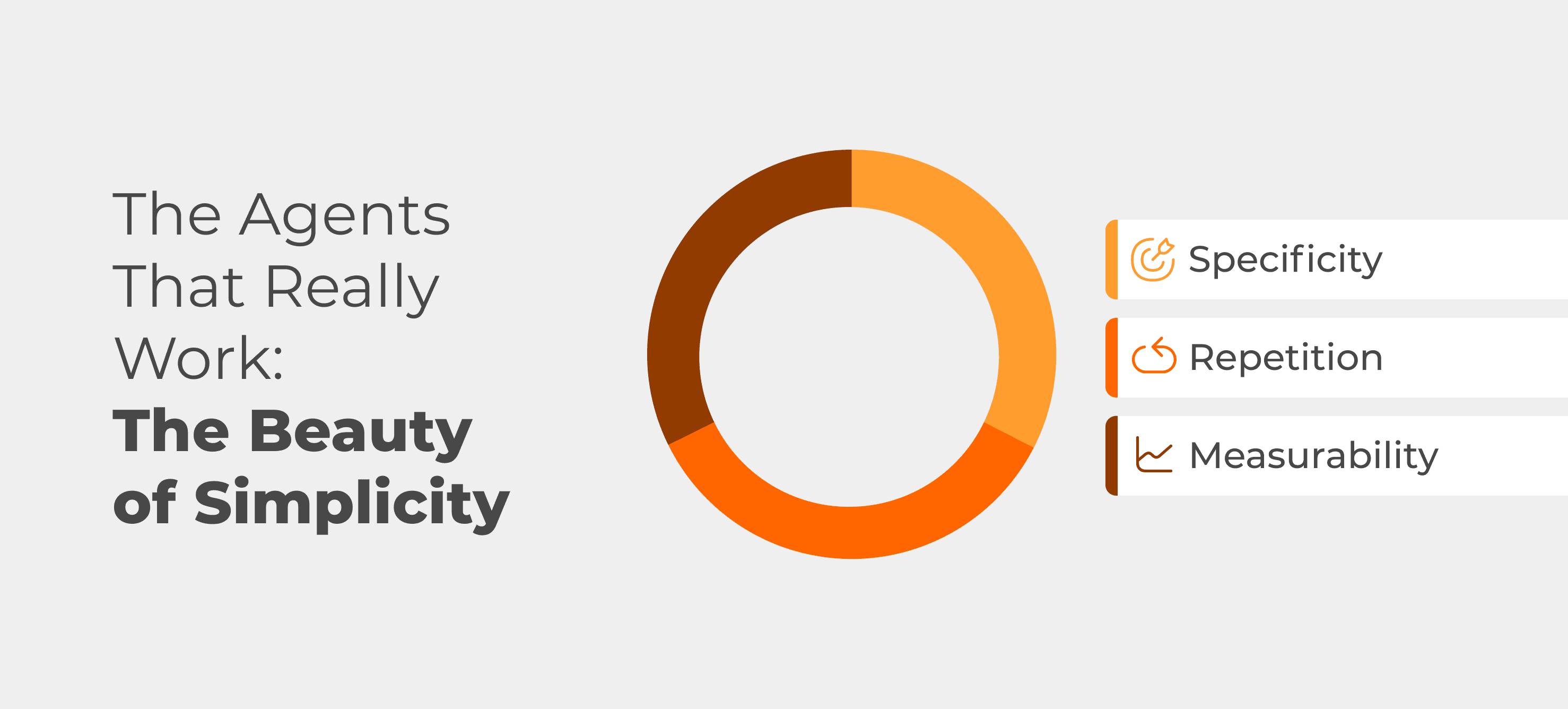The Truth About AI Agents: Beyond the Hype, Inside the ROI

The artificial intelligence market is in a peculiar moment. While executives watch impressive demonstrations of AI Agents promising to revolutionize entire operations, finance departments ask uncomfortable questions: where is the return on investment? The dissonance between technological marketing and operational reality has never been more evident.
This contradiction is not accidental. It reflects a natural phase of technological maturation, where initial enthusiasm must give way to economic pragmatism. AI Agents represent one of the most promising technologies of the decade, but their successful implementation requires deep understanding that transcends the simplified market narratives.
The central question is not whether AI Agents work, they do. The question is understanding how, when, and why to implement them in ways that generate measurable and sustainable value. This article explores that reality beyond fast-paced videos and inspiring keynotes, delving into the territory where technology meets economic viability.

The Anatomy of Hype: Why Demos Deceive
The tech industry has developed its own language to showcase innovation. Terms like “infinite productivity,” “total automation,” and “revolutionary intelligence” dominate presentations and marketing materials. This rhetoric, while effective in capturing attention, obscures the true nature of AI Agents and their practical limitations.
Typical demonstrations follow a predictable pattern: controlled environments, carefully selected use cases, and metrics emphasizing technical capability over economic impact. The result is a distorted perception that equates technological sophistication with immediate commercial value.
The operational reality of AI Agents is far more modest. They don’t replace entire teams or transform organizations overnight. Instead, they function as specialized tools that automate specific processes with increasing efficiency over time.
This gap between expectation and reality doesn’t diminish the potential of AI Agents, it redefines how we should approach them. The value lies not in the grandeur of the promise, but in the consistency of execution in well-defined tasks.
The Agents That Truly Work: The Beauty of Simplicity

Contrary to popular narrative, the most effective AI Agents are those that perform seemingly mundane tasks with absolute consistency. They process invoices, classify documents, respond to standardized queries, or monitor systems for anomalies. There’s no glamour in these functions, but there is tangible value.
Their effectiveness lies in three fundamental traits: specificity, repeatability, and measurability. They are designed to solve well-defined problems, perform the same operations repeatedly without fatigue, and deliver results that can be quantified in time saved or errors avoided.
An agent that automatically processes 200 reimbursement requests per day, detecting inconsistencies and flagging exceptions for human review, may not impress in a demo. Yet by eliminating 15 hours of manual work per week and reducing processing errors by 90%, it becomes indispensable to operations.
This operational invisibility is, paradoxically, a mark of success. When an AI Agent becomes a natural part of the workflow, when its absence would be immediately noticed, it transcends novelty and becomes critical infrastructure.
The Real Economics of AI Agents: CFOs vs. CTOs
The differing perspectives between financial and technical executives on AI Agents reveal fundamental tensions in technology adoption. While CTOs focus on technical capability and future potential, CFOs demand economic justification grounded in hard data.
This tension, when managed well, is productive. CFOs push organizations to define clear success metrics: reduced operational costs, higher throughput, fewer errors, better customer satisfaction. These tangible metrics contrast with the technical ones traditionally favored by development teams.
The ROI of AI Agents is rarely spectacular in the first few months. They require upfront investment in development, training, and integration, followed by an optimization period during which value compounds gradually. Returns appear through compounded efficiencies: processes that once required constant human intervention begin to operate autonomously, freeing resources for higher-value activities.
Financial perspective also introduces sustainability criteria often neglected during the initial tech euphoria. An agent that saves $50,000 annually in labor costs but costs $30,000 in maintenance and infrastructure still produces a net value of $20,000. This mathematical clarity guides more informed investment decisions.
Technical Ease, Operational Complexity
The paradox of modern AI Agents lies in the disparity between the simplicity of development and the complexity of implementation. Open-source frameworks, standardized APIs, and pre-trained language models have made the technical creation of agents easier than ever.
However, this technical accessibility masks significant operational challenges. Choosing the right process to automate requires deep analysis of existing workflows, identifying real bottlenecks, and understanding exceptions that could compromise automation.
Operational maintenance poses unique difficulties. AI Agents operate in dynamic environments where data, systems, and processes constantly evolve. An agent that works flawlessly with a specific document format may fail completely when that format changes. Managing such changes requires monitoring, versioning, and updating processes that many organizations underestimate.
Exceptions are another critical point. While humans intuitively handle edge cases, agents require explicit rules for every possible scenario. Poor exception handling can lead to cascading failures that disrupt entire operations.
Algorithmic transparency is becoming an essential requirement, especially in regulated sectors. Explaining why an agent made a particular decision is crucial for compliance and auditing, demanding architectures that prioritize interpretability alongside performance.
Real-World Use Cases: Where Agents Deliver Value
Successful AI Agent implementations focus on domains where volume, repetitiveness, and standardization converge. Customer support is a prime example: frequent inquiries about order status, return policies, or technical specifications can be automated with high effectiveness.
In finance, agents specializing in credit analysis process thousands of applications daily, applying consistent criteria and identifying risk patterns. Accuracy may not surpass expert analysts in complex cases, but speed and consistency in standardized ones create substantial value.
Supply chain operations benefit from agents that monitor inventory, forecast demand, and automate reordering based on predefined parameters. These systems don’t revolutionize logistics, but they eliminate manual delays and reduce inventory costs through continuous optimization.
In large organizations, document processing offers significant opportunities. Agents that extract data from contracts, invoices, and reports, automatically classifying and routing exceptions for human review, can process volumes unmanageable for manual teams.
Pragmatic Implementation: The Path to Sustainable Value
Moving from concept to productive implementation requires disciplined methodology. The first step is auditing existing processes to identify ideal candidates: high-frequency, low-cognitive-complexity activities with measurable economic impact.
Prototyping should prioritize functionality over sophistication. A simple agent that automates 80% of a process is preferable to a complex system that promises full automation but fails in real-world scenarios. Incremental iteration allows continuous learning and risk reduction.
Integration with legacy systems often represents the greatest technical challenge. Agents must consume data from multiple sources, often through inconsistent or nonexistent APIs. Investment in integration infrastructure is critical for long-term success.
Operational monitoring should be built in from the start. Performance metrics, decision logs, and anomaly alerts enable proactive maintenance and ongoing optimization. Without these systems, effectiveness silently degrades over time.
Change management cannot be overlooked. Employees affected by automation need retraining for higher-value tasks, and escalation procedures must be established for situations that exceed agent capabilities.
Governance and Compliance Challenges
The autonomy of AI Agents introduces complex corporate governance issues. When an agent makes thousands of decisions daily, establishing accountability and auditability becomes essential. Organizations must develop frameworks that balance operational efficiency with adequate controls.
Decision explainability is increasingly important, especially in sectors like healthcare, finance, and HR. Agents that operate as “black boxes” may create short-term efficiency but pose significant regulatory and reputational risks.
Data privacy demands special attention. Agents frequently process sensitive information, and their architecture must incorporate privacy-by-design principles. Data location, retention, and access control become critical compliance issues.
Managing algorithmic bias requires ongoing vigilance. Agents trained on historical data may perpetuate or amplify existing biases, leading to discriminatory outcomes. Regular audits and model adjustments are essential for mitigating these risks.
The Pragmatic Future of AI Agents
The maturation of the AI Agent market will follow predictable patterns seen in other disruptive technologies. The current experimental phase will give way to consolidation, where proven solutions dominate specific markets.
Vertical specialization will emerge as a key differentiator. Generic agents will be replaced by domain-optimized solutions embedding industry knowledge and standardized workflows.
Integration with corporate ecosystems will deepen. Isolated agents will evolve into coordinated systems that share data and optimize operations across multiple departments.
Human-agent interfaces will grow more sophisticated. Rather than full automation, we’ll see augmented collaboration, where humans and agents complement each other’s strengths.
Regulation will inevitably tighten. Industry standards for transparency, auditability, and accountability will emerge, shaping architectures and development processes.
Conclusion
The truth about AI Agents lies at the intersection of technological potential and economic reality. They are neither the magic solution promised by marketing nor immature technology without practical value. They are powerful tools that, when implemented pragmatically and focused on measurable results, generate sustainable value.
Success in implementing AI Agents requires abandoning grand narratives in favor of rigorous process analysis, proper infrastructure investment, and commitment to iterative improvement. Organizations that understand these dynamics position themselves to capture meaningful value, while others remain trapped between hype and disappointment.
The next decade won’t be defined by the most impressive agents in demos, but by the most effective ones in real operations, those that save time, reduce errors, and become invisible within organizational routines. This invisibility, far from being a failure, marks the ultimate success: when technology transcends novelty to become essential infrastructure.
The path to that success is clear: start small, measure rigorously, and scale based on results. In the end, AI Agents are like any other business investment, their value manifests not in technical sophistication, but in measurable contribution to organizational goals.
